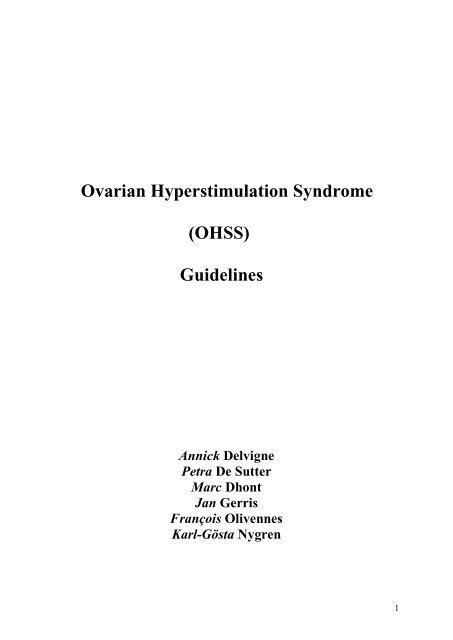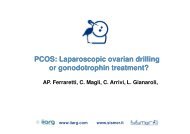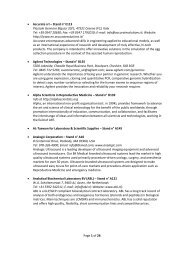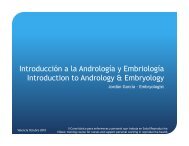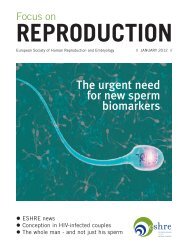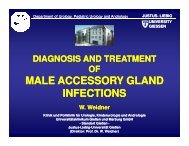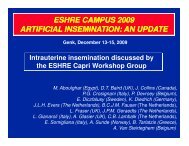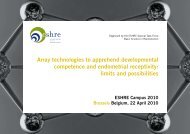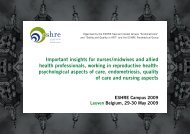Ovarian Hyperstimulation Syndrome - eshre
Ovarian Hyperstimulation Syndrome - eshre
Ovarian Hyperstimulation Syndrome - eshre
You also want an ePaper? Increase the reach of your titles
YUMPU automatically turns print PDFs into web optimized ePapers that Google loves.
<strong>Ovarian</strong> <strong>Hyperstimulation</strong> <strong>Syndrome</strong>(OHSS)GuidelinesAnnick DelvignePetra De SutterMarc DhontJan GerrisFrançois OlivennesKarl-Gösta Nygren1
1. DESCRIPTION OF THE PROBLEM1.1 DefinitionThe ovarian hyperstimulation syndrome (OHSS) is an iatrogenic complication of theluteal phase or/and early pregnancy after ovulation induction (provoking ovulation inanovulatory women) or of ovarian stimulation (in the context of intrauterine insemination orin vitro fertilisation).1.2 Essential characteristicsDe essence of the OHSS is cystic enlargement of the ovaries and a fluid shift from theintravascular to the third space due to increased capillary permeability and ovarian neoangiogenesis.Its occurrence is dependent of the administration of human chorionicgonadotropin (HCG). Without HCG, OHSS is extremely rare. Its impact on the general healthof the patient may be very important. Fatal cases have occasionally been reported.1.3 Early and late form of OHSSThe early form of OHSS, although elicited by HCG, is related to an exaggerated ovarianresponse to gonadotropin stimulation, whereas the late form is mainly related to the secretionof placental HCG. The most recent definition (Mathur et al., 2000) still relies on theunderlying aetiology but makes a clear distinction between the early form (
Nausea and vomiting preventing intake of food and fluids.Dyspnoea and respiratory distress due to an elevated diaphragm and hydrothorax.Diarrhoea.Quick weight gain.More severe signs and symptoms Ascites. Hypotension. Pleural effusion (more and more frequently at the right side). Pericardial effusion. Adult form of RDS Oliguria and anuria Multiple organ failure. Death (1/500.000 cycles) (Brinsden et al., 1995)Biological findings Electrolyte disorders (hyponatriemia 5.0 mEq/l). Hypovolemia. Hemoconcentration (hematocrit >45%). Leucocytosis >15.000/mm 3 Creatinin clearance 1.2mg/dl. Elevated liver enzymes. Hypercoagulability. Hypoproteinemia and hypoalbuminemia (
2.3 Primary risk factorsPolycystic ovarian syndrome (PCOS)Patients with some characteristics of PCOS:o High number of follicles in both ovaries at the quiescent state beforestimulation (≥10 follicles of 4-10mm in each ovary).o LH/FSH ratio >2.o HyperandrogenismHistory of OHSSYoung patientsLean womenAllergic predisposition2.4 Secondary risk factors Maximum serumestradiol >3000-4000 pg/ml.o No clear cut-off valueo Relatively poor predictive power (max. 73%).o Oestradiol itself is no mediator since OHSS is also possible withlow serum oestradiol values (stimulation with recFSH)o The slope of the oestradiol rise is the main risk factor and is of moreimportance than the maximum level (PPV 77%). Number of follicles per ovary >20-25.o No clear cut-off value (10-35).o Variation dependent upon operator and technique. Measurements of the absolute VEGF (vascular endothelial growth factor)-serum concentration are not useful for individual prediction (Mathur et al.,2002).2.3 PhysiopathologyThe physiopathology of the OHSS is increasingly better understood. The crux is anequilibrium between pro-angiogenic and anti-angiogenic factors present in follicular fluid.The pro-angiogenic role of the vascular endothelial growth factor (VEGF) is an importantmediator of the syndrome (Pellicer et al., 1999; Garcia-Velasco and Pellicer, 2003). Highconcentrations of VEGF have been demonstrated in follicular fluid, making the mediating roleof ovarian VEGF in the development of OHSS very plausible. VEGF concentrations in asciticfluid, serum and plasma concentrations in OHSS patients were shown to be increased(McClure et al., 1994; Abramov et al., 1997; Agrawal et al., 1999). mRNA expression ofVEGF in human luteinized granulosa cells is time- and dose dependent of HCG furtherunderlining the role of VEGF in the development of the OHSS (Neulen et al. 1995, 1998).Later it was shown that two VEGF-receptors exist (VEGFR-1 en VEGFR-2), both producedby endothelial cells, of which one exists in a soluble form, s(serum)VEGFR-1, acting as anegative modulator of the bioactivity of VEGF.Excess of bioactive pro-angiogenic VEGF increases the risk for OHSS; excess of antiangiogenicsVEGFR-1 (and other anti-angiogenic factors) decreases the ovarian response andthe risk for OHSS and is accompanied by a decreased pregnancy rate (Pellicer et al., 1999).Absolute serum concentrations have no value in the individual risk assessment because there4
are individual variations in the binding of VEGF to its receptors (Mathur et al., 2002; Garcia-Velasco JA and Pellicer, 2003).In rats, proof of concept was shown of a VEGF-2 inhibitor (SU5416) to block HCGdependentVEGF-production (and ensuing neo-angiogenesis) (Gomez et al., 2002). Also inrats it was shown that ovulation triggering using LH instead of HCG results in lower VEGFproduction.This serves as the theoretical basis for ovulation triggering utilizing rLH inclinical situations (Gomez et al., 2004).The physiopathological cascade of the OHSS consists of: neo-angiogenesis andincreased capillary permeability of the enlarged ovarian and other endothelial surfaces, fluidshift from the intravascular space to the extravascular space (abdomen, pleura, pericard),hemoconcentration, decreased renal clearance, oliguria/anuria, hyperviscositity of blood,modification in coagulation factors and thrombo-embolic risks. Hemoconcentration leads toan increase of the hematocrit, of the concentration of platelets and leucocytes, creatinin,ureum and liver enzymes in the plasma, as well as to hyperkaliemia and acidosis. Serumalbumin decreases as a result of extravasation of fluid and ascites formation. The process isself limiting as the HCG-effect decreases unless fetal HCG starts to be secreted.2.1 ClassificationThe quantitative aspects of the definition of the syndrome can not exactly be measured:ovarian dimensions can be assessed to a certain extent using echography, but ascites volumeis difficult to measure. Therefore classification is not categorical and daily weighing and fluidbalance assessment remain key elements of the clinical follow-up. The most frequently usedclassification system used is the one proposed by Golan (Golan et al, 1989).Classification of OHSS according to Golan (1989)OHSSGrade Mild Moderate Severe1. Abdominal distentionand discomfort2. Criteria of grade 1 +nausea, vomiting,and/or diarrhoea.Ovaries enlarged 5-12 cm3. Criteria of mildOHSS +echographicsigns of ascites4. Criteria of moderate OHSS +clinical signs of ascites and/orhydrothorax and respiratory distress5. All of the above + changes in bloodvolume and viscosity,hemoconcentration, coagulationdisorders and decreased renal outputand function6. Life-threatening form5
Subsequently, two further refinements were introduced: “critical OHSS” (Navot etal., 1992) and “group C severe OHSS” (Rizk and Aboulghar, 1999), who both describethe same life threatening clinical entity: severe reduction in circulating volume, severehemoconcentration, multiple organ failure (kidney, liver, heart) and/or thrombo-embolicsymptoms. Both are considered as grade 6 in the modern classification of Golan.It is essential to understand that these grades are not strictly separated entities and thata mild grade OHSS can quickly evolve into a severe OHSS. This should not be forgottenwhen deciding to follow-up a patient “by telephone”. The foremost criterion of clinicalseriousness implying immediate hospitalization is a hematocrit >45%.2. PREVENTION3.1 Primary prevention.Patients who have a primary risk for OHSS should be exposed to gonadotropins aslittle as possible. This implies that all other more safe treatments should have had fairchances: life style changes ( diet and exercise), oral ovulation induction, use of pulsed GnRH,laraposcopic ovarian surgery. This should especially be kept in mind when treating youngwomen in their first ART treatment cycles, women with PCOS and women with a history ofOHSS.Identification of women with thrombophilia, a family history of thrombo-embolismand women with antiphospholipid antibodies should ideally be performed before startinggonadotropin treatment. When indicated, the lowest possible dose of gonadotropins should beused and treatment adequately monitored, which means frequent use of vaginal echographyand of serum oestradiol measurements. All patients at risk should be informed orally and inwritten so that at the occurrence of early symptoms, they should consult the responsiblegynaecologist and not an inexperienced physician.In cases of high primary risk, prophylactic treatment with heparin has been proposed.3.2 Secondary prevention.3.2.1 Cycle cancellation.In ovulation-induction withholding HCG prevents the early form of OHSS. AvoidingHCG and intercourse/insemination prevents both the early and the late form. This decision isoften psychologically difficult, especially in IVF, because it may entail the loss ofconsiderable financial efforts in countries without reimbursement. In very severe cases withpoor follow-up possibilities, however, it may be the only method to avoid disaster.3.2.2 Coasting (“Soft landing”)PrincipleWhen high risk patients rapidly reach high (>3000 pg/ml) serum oestradiol levels witha large number (>20 per ovary) of follicles during stimulation, gonadotropin administrationcan be decreased or stopped while continuing Gn-RH agonist administration. This allowslarger follicles to continue to grow, whereas intermediary and small follicles enter atresia.Based on the FSH-threshold theory, a number of follicles will not respond any longer to thedecreasing FSH levels or become unresponsive to HCG (Fluker et al., 1999). Coasting causes6
a down regulation of VEGF-gene expression and protein production as a result of increasedapoptosis in granulosa cells of all, but mainly immature follicles, without influence on oocytequality and endometrial receptivity (Garcia-Velasco et al., 2004).Although no randomized clinical trials have been conducted to assess its trueefficiency, the method is very popular and is followed by acceptable pregnancy rates(Delvigne et al, 2001). It has the advantage that the cycle is brought to its expected end withthe replacement of fresh embryos and that no additional technical procedures are needed.Criteria for coastingCriteria for coasting are based on a relationship between the number of growingfollicles and/or the serum oestradiol levels and the risk for OHSS. There are two criteria fordecision: the serum-E 2 -levels determines whether coasting is done or not; the echographicimage determines when.Serum oestradiol levelsMost authors use values between 2500-3000 pg/ml. Continuing gonadotropins at aserum oestradiol level of >3000 pg/ml is considered not good clinical practice. When usingrecFSH, oestradiol values tend to be lower and the above criteria do not hold. It has thereforebeen suggested that the oestradiol value should come into play only if at the same time thereare >20 follicles per ovary.Number of growing folliclesCoasting should not be started too early because follicle growth might come to acomplete standstill. When >30% of all follicles have reached a mean diameter of 15mm,coasting will result in an abrupt stop in follicle development and a quick serum E 2 -decrease.On the other hand, when the majority of follicles are >15mm at the start of coasting, a numberof cystically enlarged follicles with decreased oocyte quality may ensue (Sher et al., 1995).Hence the rule of the golden middle way: coasting should start when ~50% of the follicles are~15mm in diameter and have become independent of further gonadotropin stimulation.Duration of coastingIt has been shown that a coasting period of ≥4 days (from the first day thegonadotropin dose is interrupted or decreased) results in decreased pregnancy rates (Ulug etal., 2002), but this remains controversial (Sher et al., 1995; Delvigne et al., 2003b). Furtherclinical research is desirable to assess the subtleties with respect to oocyte numbers andquality and endometrial receptivity.3.3.3 Modification of the ovulation triggering agent.Although good data are lacking, it is not impossible that lower doses of HCG thanthose usually utilized (5000 or 10.000 IU) may cause sufficient oocyte maturation whilereducing the risk for OHSS.Replacement of HCG by exogeneous or endogeneous LH as ovulation trigger couldhave a considerable impact on the incidence of the (early form of) OHSS. An endogenous LHsurge can be provoked by the administration of a short-acting GnRH agonist (Emperaire en7
Edwards, 2004). This only possible in cycles without pituitary desensitization by a GnRHagonist. The combination with an antagonist remains a possibility. Administration ofexogeneous LH (recLH) is another option but for the time being there is no interest from theside of the pharcameutic industry to commercialise this (available) product for this indication.So it remains that the 50 year old use of urinary HCG as ovulation trigger is much cheaper butthe impact on the incidence of OHSS is huge.3.3.4 Administration of macromolecules.Albumin administration.Prophylactic albumin administration is supposed to interrupt the developmentof OHSS by increasing the plasma oncotic pressure and binding mediators of ovarian origin.This effect could be counteracted by increased capillary permeability. Prospective randomizedtrials and one retrospective study with a control group show 39 cases of OHSS in 468 treatedrisk cycles (8.3%) versus 89 OHSS cases in 611 untreated risk cycles (14.6%) (Delvigne etal., 2003). The Cochrane review also shows that IV albumin administration at the time ofoocyte collection has a preventive effect in cycles with a severe risk for OHSS (Aboulghar etal., 2002). However, a recent prospective randomized trial of 488 cases in each arm of thestudy seems to prove the inefficiency of human albumin (Bellver et al., 2003). Two studiesshow a decreased pregnancy rate after the use of IV albumin (Shaker et al., 1996; Costabile etal., 2000). Albumin administration also has side effects: viral transmission, nausea, vomiting,febrile and allergic reactions, and it is expensive.Hydroxyethyl starch solution (HEAS)Because of the risk of viral transmission with human albumin, some authorshave tested the effect of a safer non-biological substitute with comparable physiologicalproperties: HEAS. Three studies suggest a useful effect but the cohorts are too small to drawdefinite conclusions (Graf et al., 1997; Knig et al., 1998; Gökmen et al., 2001). Furtherclinical research seems warranted.3.3.5 Cryopreservation of all embryos.Instead of cancelling the cycle, it is also possible to administer HCG, toretrieve the oocytes and to freeze all embryos. This does not exclude the risk for the earlyform of OHSS but it does exclude the late form (caused by pregnancy). The removal of alarge number of granulosa cells from the follicles probably does decrease the risk as well. TheCochrane review concludes that the present evidence is insufficient to consider this approachas the standard of treatment (D‟Angelo en Amso, 2002). It may be considered when coastinghas not been applied when it should have and when at the time of oocyte retrieval one findsoneself in a very high risk situation for the early form of OHSS in a patient with a very goodprognosis of becoming pregnant and hence has a high risk for the late form of OHSS.3.3.5 SummaryNo method can prevent all cases of OHSS, apart from withholding HCG, still8
the ubiquitous ovulation triggering agent, although other molecules exist (rLH) but are eithernot available or very expensive. In practice, in ART coasting is still the most popularapproach, which probably does have some preventive effect. The late form cannot becompletely avoided altogether. Combinations of different preventive methods acting atdifferent levels could give the opportunity to avoid completely OHSS (Isik et al., 2001).Single embryo transfer after ART prevents multiple pregnancies but not the OHSS (DeNeubourg et al. 2004).3. CLINICAL MANAGEMENT.4.1 Criteria for hospitalisation Hematocrit >45% Any sign of severe OHSS4.2 Elements of outpatient follow-upDaily fluid balanceDaily weighingIncrease in umbilical abdominal circumferenceInstruction to contact the centre at any sign of deteriorationOutpatient follow-up every 48-72 hours with blood tests andultrasound examination4.3 Elements of hospital follow-upHeartrateBlood pressureDaily fluid balanceEchografic assessment: ascites volume, ovarian dimensionsRX thorax ( if dyspnoeic ) to diagnose pleural effusionECG (to exclude pericardiac effusion)Hematological examination: hematocrit, RBC count, WBC count,electrolytes, kidney function tests, liver enzymes, total serum proteinand albumin, coagulation tests4.4 Treatment strategy4.4.1 Maintain diuresis!Fluid managementIntravenous administration of Ringer lactate solutionFirst 24 hours: 1500-3000ml. In order to avoid overadministration offluid, some centres restrict total fluid intake (inclusive oral) to1500ml.Subsequent days: fluid volume in function of fluid balance9
Combination of Ringer lactate + Dextrose 5% solution or NaCl 0.9%+ Dextrose 5% (standard) solutionPlasma expandersHEAS ( hydroxyethyl starch ) 6% solution in isotonic NaCl.Maximal daily dose: 33ml/kg in 250-500 ml per day, dropwise,utilising slow administration to avoid lung congestion.Albumin administrationIs only started if hypo-albuminemia (
4.5 Pregnancy after OHSS.The pregnancy rate in patients with OHSS is higher than average. This is becauseThe patients usually are young women, in their first ART cycles, with many oocytes and goodquality embryos. Several authors have reported an increase in early pregnancy loss in OHSSpatients (Raziel et al., 2002; Papanikolaou et al., 2004).4. CONCLUSIONS AND RECOMMENDATIONSAlthough theoretically known, OHSS remains underestimated because the perceivedincidence per gynaecologist is low. The affection is very traumatizing for the patient and herpartner. Subjective discomfort is very important and objective changes may be dramatic.Although long term sequelae are rare, they are serious (thrombo-embolism). Although fatalcases are rare, they go unreported and so may be underestimated and they are never inproportion to the indication for treatment (infertility in young healthy women).Essential recommendations therefore are:1. Gonadotropin treatment for ovulation induction only when all other options havefailed after a sufficiently long trying time.2. If gonadotropin stimulation for ovulation induction is unavoidable, one shoulduse “friendly” stimulation regimens aiming at “SOFT” ( single ovarian follicletreatment ): low dose step-up regimen, step-down regimen, or use antagonists,always utilising blood and sonographic control of ovarian response.3. HCG as an ovulation trigger should be replaced by safer methods (rLH,endogenous GnRH-surge by an agonist); they exist but are not commerciallyavailable.4. In IVF/ICSI the principle of obtaining “as many oocytes as possible” should bereplaced by softer stimulation regimens aiming at less oocytes of good quality.5. In risk situations the patient should be informed about possibilities such ascancelling, coasting or freezing for subsequent replacement.6. When signs of OHSS occur, the patient must be completely informed andhospitalization should be proposed at the slightest deterioration.7. These patients belong in a hospital ward where the clinical picture is known andthe personnel have expertise in its treatment and follow-up. Admission to anintensive care unit is necessary when critical OHSS develops.8. Registration of all cases of severe OHSS and their outcome should becomecompulsory in all ART programmes as well as after ovulation induction.5. REFERENCESAboulghar MA, Mansour RT, Serour GI en Amin T (1990) Ultrasonically guidedvaginal aspiration of ascites in the treatment of ovarian hyperstimulation syndrome. FertilSteril 53: 933-935.Aboulghar M, Evers JH en All-Inany H (2002) Intravenous albumin for preventing severe11
ovarian hyperstimulation syndrome: a Cochrane review. Hum Reprod 17: 3027-3032Abramov Y, Barak V, Nisman B en Schenker JG (1997) Vascular endothelial growthfactor plasma levels correlate to the clinical picture in severe hyperstimulation syndrome.Fertil Steril 67: 261-265.Abramov Y, Elchalal U en Schenker JG (1999) Severe OHSS: An „epidemic‟ of severeOHSS: a price we have to pay? Hum Reprod 14: 2181-2183.Agrawal R, Tan SL, Wild S, Sladkevicius P, Engmann L, Payne N, Bekir J, Campbell S,Conway G en Jacobs H (1999) Serum vascular endothelial growth factor concentrations inin vitro fertilization cycles predict the risk of ovarian hyperstimulation syndrome. FertilSteril 71: 287-293.Bellver J, Munoz EA, Ballesteros A, Soares SR, Bosch E, Simon C, Pellicer A en RemohiJ. (2003) Intravenous albumin does not prevent moderate-severe ovarian hyperstimulationsyndrome in high-risk IVF patients: a randomized controlled study.Hum Reprod;18:2283-2288.Brinsden PR, Wada I, Tan SL, Barlen A en Jacobs HS (1995) Diagnosis, prevention andmanagement of ovarian hyperstimulation syndrome. Br J Obstet Gynaecol 102: 767-772.Costabile L, Unfer V, Manna C, Gerli S, Rossetti D en Di Renzo (2000) Use ofintramuscular progesterone versus intravenous albumin for the prevention of ovarianhyperstimulation syndrome. Gynecol Obstet Invest 50: 182-185.D‟Angelo A en Amso NN (2002) Embryo freezing for preventing ovarianhyperstimulation syndrome: a Cochrane review. Hum Reprod 17: 2787-2794.Delvigne A en Rozenberg S (2001) Preventive attitude of physicians to avoid OHSS inIVF patients. Hum Reprod 16: 2491)2495.Delvigne A en Rozenberg S (2003a) Review of clinical course and treatment of ovarianhyperstimulation syndrome (OHSS). Hum Reprod Update 9:77-96.Delvigne A, Kostyla K, Murillo D, Van Hoeck J en Rozenberg S (2003b) .Oocyte qualityand IVF outcome after coasting to prevent ovarian hyperstimulation syndrome.Int J Fertil Womens Med;48:25-31.De Neubourg D, Mangelschots K, Van Royen E, Vercruyssen M en Gerris J (2004)Singleton pregnancies are equally affected by ovarian hyperstimulation syndrome as twinpregnancies. Fertil Steril 82:1691-1693.Emperaire JC en Edwards RG (2004) Time to revolutionize the triggering of ovulation.Reprod Biomed Online 9: 480-483.12
Fluker MR, Hooper WM en Yuzpe A (1999) Withholding gonadotropins (“coasting”) tominimize the risk of ovarian hyperstimulation suring superovulation and in vitrofertilization-embryo transfer cycles. Fertil Steril 71: 294-301.Garcia-Velasco JA en Pellicer A (2003) New concepts in the understanding of the ovarianhyperstimulation syndrome. Curr Opin Obster Gynecol 15: 251-256.Garcia-Velasco JA, Zuniga A, Pacheco A, Gomez R, Simon C, Remohi J en PellicerA (2004) Coasting acts through downregulation of VEGF gene expression and proteinsecretion. Hum Reprod 19: 1530-1538.Gökmen O, Ugur M, Ekin M, Keles G en Turan C, Oral H (2001) Intravenous albuminversus hydroxyethyl starch for the prevention of ovarian hyperstimulation in an in-vitrofertilization programme: a prospective randomized placebo controlled study. Eur J ObstetGynecol Reprod Biol 96: 187-192.Golan A, Ron-El R, Herman A, Soffer Y, Weinraub Z en Caspi E (1989) <strong>Ovarian</strong>hyperstimulation syndrome: an update review. Obstet Gynecol Surv 44: 430-440.Gomez R, Simon C, Remohi J en Pellicer A (2002) Vascular endothelial growth factorreceptor-2 activation induces vascular permeability in hyperstimulated rats, and thiseffect is prevented by receptor blockade. Endocrinology 143: 4339-4348.Gomez R, Lima I, Simon C en Pellicer A (2004) Low dose LH administration inducesovulation and prevents vascular hyperpermeability and VEGF expression in superovulatedrats. Reproduction 127: 483-489.Graf MA, Fischer R, Naether OG, Baukloh V, Tafel J en Nuckel M (1997) Reducedincidence of ovarian hyperstimulation syndrome by prophylactic infusion ofhydroxyaethyl starch solution in an in-vitro fertilization programme. Hum Reprod 12:2599-2602.Isik AZ en Vicdan K.(2001) Combined approach as an effective method in the preventionof severe ovarian hyperstimulation syndrome. Eur J Obstet Gynecol Reprod Biol; 97:208-212.Knig E, Bussen S, Sutterlin M en Steck T (1998) Prophylactic intravenous hydroxyethylstarch solution prevents moderate-severe ovarian hyperstimulation in in-vitro fertilizationpatients: a prospective, randomized, double-blind and placebo-controlled study. HumReprod 13: 2421-2424.Mashiach S, Bider D, Morano Goldenberg M en Ben Rafael Z (1990) Adnexal torsion ofhyperstimulated ovaries in pregnancies after gonadotropin therapy. Fertil Steril 53: 76-80.Mathur RS, Akande AV, Keay SD, Hunt LP en Jenkins JM (2000) Distinction betweenearly and late ovarian hyperstimulation syndrome. Fertil Steril 73: 901-907.13
Mathur R, Hayman G, Bansal A en Jenkins J (2002) Serum vascular endothelial growthfactor levels are poorly predictive of subsequent ovarian hyperstimulation syndrome inhighly responsive women undergoing assisted conception. Fertil Steril 87: 1154-1158.McClure N, Healy DL, Rogers PAW, Sullivan J, Beaton L, Hanning RV, Connoly DT enRobertson DM (1994) Vascular endothelial growth factor as capillary permeability agentin ovarian hyperstimulation syndrome. Lancet 344: 235-236.Navot D, Bergh PA en Laufer N (1992) <strong>Ovarian</strong> hyperstimulation syndrome in novelreproductive technologies: prevention and treatment. Fertil Steril 58: 249-261.Neulen J, Yan Z, Raczek S, Weindel K, Keck C, Weich HA, Marme D en Breckwoldt M(1995) Human chorionic gonadotropin dependent expression of vascular endothelialgrowth factor/vascular permeability factor in human granulosa cells: importance inovarian hyperstimulation syndrome. J. Clin Endocrinol Metab 80: 1967-1971.Neulen J, Raczek S, Pogorzelski M, Grunwald K, Yeo KT, Dvorak HF, Weich HA enBreckwoldt M (1998) Secretion of vascular endothelial growth factor/vascularpermeability factor from human luteinized granulosa cells is human chorionicgonadotrophin dependent. Mol Hum Reprod 4:203-206.Padilla SA, Zamaria S, Baramki TA en Garcia JE (1990) Abdominal paracentesis forovarian hyperstimulation syndrome with severe pulmonary compromise. Fertil Steril 53:365-367.Papanikolaou E, Tournaye H, Verpoest W, Camus M, Vernaeve V, Van Steirteghem A enDevroey P (2004) Early and late ovarian hyperstimulation syndrome: early pregnancyoutcome and profile. Hum Reprod (in press).Pellicer A, Albert C, Mercader A, Bonilla-Musoles F, Remohi J en Simon C (1999) Thepathogenesis of ovarian hyperstimulation syndrome: in vivo studies investigating the roleof interleukin-1, interleukin-6, and vascular endothelial growth factor. Fertil Steril 71:482-489.Raziel A, Friedler S, Schachter M, Strassburger D, Mordechai E en Ron-El (2002).Increased early pregnancy loss in IVF patients with severe hyperstimulation syndrome.Hum Reprod 17: 107-110.Rizk B en Aboulghar MA (1999) Classification, pathophysiology and management ofovarian hyperstimulation syndrome. In Brinsden P (ed.) In-Vitro Fertilization andAssisted Reproduction. The Parthenon Publishing Group, New York, London, pp. 131-151.Shaker A, Zosmer A en Dean N (1996) Comparison of intravenous albumin and transferof fresh embryos with cryopreservation of all embryos for subsequent transfer inprevention of ovarian hyperstimulation syndrome. Fertil Steril 65: 992-996.Sher G, Zouves C, Feinman M en Maassarani G (1995) “Prolonged coasting”: an effectivemethod for preventing severe ovarian hyperstimulation syndrome in patients undergoingin-vitro fertilization. Hum Reprod 10: 3107-3109.14
Stewart JA, Hamilton PJ en Murdoch AP (1997) Thromboembolic disease associatedwith ovarian stimulation in assisted conception techniques. Hum Reprod 12: 2167-2173.Ulug U, Bahceci M,Erden HF, Shalev E en Ben-Shlomo I (2002) The significance ofcoasting duration during ovarian stimulation for conception in assisted fertilization cycles.Hum Reprod 17: 310-313.15


